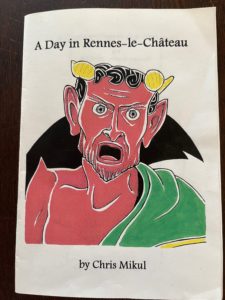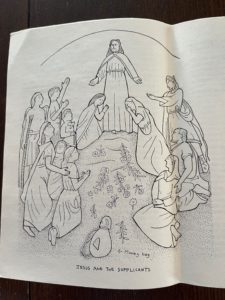Chris Mikul is a guru of the weird and bizarre and I’ve said before that I want to be him when I grow up. I probably won’t be able to move to Australia and make a living writing about weird people, odd books and strange places, but I can discuss his work and that’s a decent compromise, I think.
 Chris is the author of several books, three of which I’ve discussed here. He also produces amazing ‘zines, notably Biblio-Curiosa and Bizarrism. Because the former deals with odd books and the people who write them, I’ve discussed several editions of Biblio-Curiosa on this site, and this week I finally will discuss a couple of editions of his equally delightful Bizarrism. Today, I want to share with you a one-off ‘zine he published, A Day in Rennes-le-Château. Should you want to order any of the ‘zines I discuss here, contact Chris at chris.mikul88@gmail.com.
Chris is the author of several books, three of which I’ve discussed here. He also produces amazing ‘zines, notably Biblio-Curiosa and Bizarrism. Because the former deals with odd books and the people who write them, I’ve discussed several editions of Biblio-Curiosa on this site, and this week I finally will discuss a couple of editions of his equally delightful Bizarrism. Today, I want to share with you a one-off ‘zine he published, A Day in Rennes-le-Château. Should you want to order any of the ‘zines I discuss here, contact Chris at chris.mikul88@gmail.com.
This ‘zine is an intelligent and eminently readable synopsis of the ideas that make up the famous conspiracy that authors Henry Lincoln, Michael Baigent, and Richard Leigh shared in Holy Blood, Holy Grail, which led to Dan Brown’s bestselling book, The Da Vinci Code. A nice bonus are the sketches that Chris Mikul drew when he visited Rennes-le-Château and saw first hand the weirdness that inspired the belief that Christ was married to Mary Magdalen and she bore him children who carried on Christ’s bloodline. Two of the authors of Holy Blood, Holy Grail (Lincoln was not a party to the lawsuit) tried to sue Dan Brown for using (rather heavily) their research to create his fictional work, but in the end they were hoisted by their own petard. They insisted that their book was a recitation of historical fact, but historical fact cannot be copyrighted, and that was why they lost the lawsuit.
I have to admit that I often get a bit tangled up discussing all the history involved in this conspiracy theory because it is pretty labyrinthine, but Mikul does an excellent job breaking it down. Short version but not really: A priest named Bérenger Saunière in 1891 renovated a completely run-down church in the Languedoc region of France. Inside of what is described as a “hollow pillar” he found four “parchments.” Two had been written by a priest, Abbé Bigou, and the other two parchments were much older. No one knows exactly what was on those parchments, but after the discovery, Father Saunière became wealthy.
As Saunière displayed his new wealth, it caused people to wonder exactly what Saunière found in the old church, leading them to believe one of the parchments told the location of a treasure. Many people began to dig around and under the church to find hidden treasure, eventually causing town officials to ban digging there because there were fears that all the tunnels dug under the town could result in collapse.
Holy Blood, Holy Grail examined the significance of the church’s location in the Languedoc region, where Cathars, a medieval sect of Christianity, were sought out and persecuted, eventually being exterminated in a “mountain top” fortress. Lincoln, Baigent and Leigh believe that a few of the Cathars smuggled out all the Cathar treasures and possibly secreted them at or near Rennes-le-Château.
Alongside the theory that Cathar treasure was the source of Saunière’s sudden wealth, is the Knights of Templar connection. The Knights of Templar was created to protect Christian pilgrims as they traveled to the Holy Land. The group grew in power and wealth and eventually the King of France decided to wipe them out in order to take the group’s land and riches. Some believe the Knights knew they would soon be attacked and made moves to hide and protect their most precious relics. One of those relics may have been the Holy Grail, the cup Christ drank from at the Last Supper. Another was possibly proof that the bloodline of Jesus was represented in the Merovingian dynasty that ended in 679 AD when King Dagobert II was assassinated. The Priory of Sion, founded at the same time as the Knights Templar, maintained in secret the records that purportedly proved Jesus was the patriarch of the Merovingian dynasty.

The Merovingian angle was the crux of Holy Blood, Holy Grail, but later that thesis was disproven when it was shown that the records the Priory of Sion were protecting were forgeries. But even with that revelation, there were still plenty of things left to ponder, chief among them: how did the penniless Saunière acquire his wealth (probably by selling Masses)?
The best part of this ‘zine is Mikul’s discussion of his trip to see Rennes-le-Château, where he made sketches of the church and the weird stuff inside of it. For example, Saunière installed a giant statue of Satan that held the fount of holy water. The statue of Satan at one point held a pitchfork but it was removed for safety reasons. Painted on a wall near the statue is Christ ministering to followers with a bag of money on the ground. The signs of the cross were arranged counter-clockwise. Statues of Joseph of Arimathea and Mary, standing side by side, are each holding an infant. One depiction of Jesus shows him wearing Scottish plaid, and there is a depiction of Jesus being taken into the tomb at night rather than the afternoon as the bible describes.
 Mikul goes on to outline various problems in Saunière’s story, softly debunking the story of Jesus’ descendants without being as pedantic about it as I would be had I written this ‘zine. Even so, I find the Merovingian Jesus theory interesting and entertaining, and thoroughly enjoyed reading this ‘zine. Mikul included a “further reading” list, and I’ve read them all. The most entertaining of them all is Rat Scabies and the Holy Grail. Rat Scabies, the former drummer for The Damned, goes to France to hopefully dig up the Holy Grail. He even procured a metal detector for the search. The book caroms from one ridiculous situation to another and you should probably read it.
Mikul goes on to outline various problems in Saunière’s story, softly debunking the story of Jesus’ descendants without being as pedantic about it as I would be had I written this ‘zine. Even so, I find the Merovingian Jesus theory interesting and entertaining, and thoroughly enjoyed reading this ‘zine. Mikul included a “further reading” list, and I’ve read them all. The most entertaining of them all is Rat Scabies and the Holy Grail. Rat Scabies, the former drummer for The Damned, goes to France to hopefully dig up the Holy Grail. He even procured a metal detector for the search. The book caroms from one ridiculous situation to another and you should probably read it.
More Chris Mikul gems will pop up this week. See y’all soon.